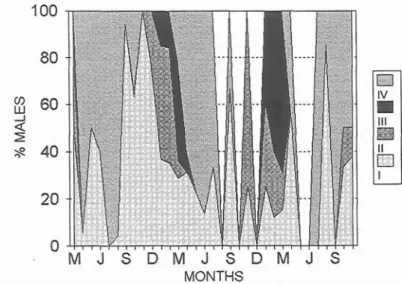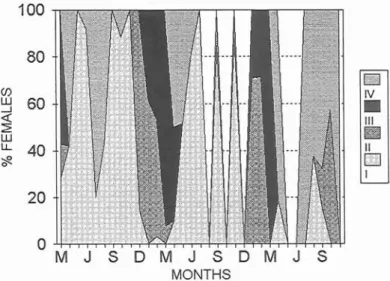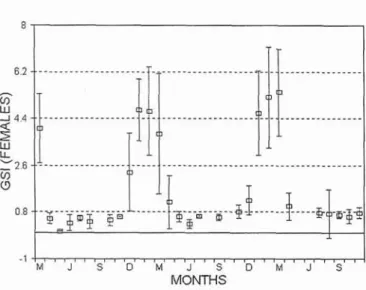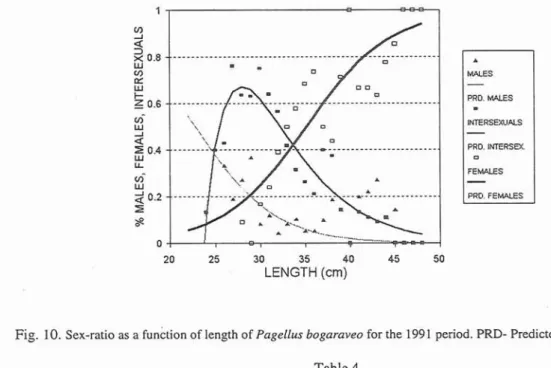VARLATION IN THE REPRODUCTIVE CYCLE OF THE BLACKSPOT
SEABREAM, PAGELLUS BOGARAVEO ( B R ~ I C H ,
1768) IN THE AZORES
HELENA
M.
KRUG
KRUG, HELENA M. 1998. Variation in the reproductive cycle of the blackspot seabream, Pagellus bogaraveo (Brunnich, 1768) in the Azores. Arquipdago. Life and Marine Sciences 16A: 37-47. Ponta Delgada. ISSN 0873-4704.
The period of spawning, fecundity, length and age of first maturity, sex-ratio and proportion of hermaphrodites were studied in samples of the blackspot seabream, Pagellus bogaraveo (Briinnich, 1768) from commercial landings at Horta. Previous data from 1982- 1986 were reorganised in two periods (1982-1983 and 1984-1986) to enable comparisons with data of 1991. Over the ten year period there have been increases in fecundity and decreases in length of first maturity in females, apparently related to changes in growth, the fish maturing at an earlier age. In contrast first maturity in males was attained at a greater length than previously, though the age was the same. The sexual transition was also altered, with an increasing proportion of intersexual forms, contrasted with an obvious decrease in males.
KRUG, HELENA M. 1998. Varia@o do ciclo reprodutivo do Goraz, Pagellus bogaraveo (Brunnich, 1768) nos Aqores. Arquipilago. CiEncias Biol6gicas e Marinhas. 16A: 37-47. Ponta Delgada. ISSN 0873-4704.
0 period0 de postura, fecundidade, comprimento e idade de primeira matura@io, rela@io entre sexos e propor@o de hermafroditas foram estudados nas amostragens de goraz, Pagellus bogaraveo (Briinnich, 1786) obtido nas desembarques comerciais do porto da Horta. 0 s dados obtidos entre 1982 e 1986, foram agrupados e separados em dois periodos (1982-1983 e 1984-1986) para possiveis compara~6es com os dados de 1991. No decorrer destes 10 anos observaram-se aumentos na fecundidade e dirninui~b no tamanho da primeira matura@o nas fheas. Pelo contr&io, nos, machos observou-se um aumento no tamanho na primeira matura@o. A transi~lo sexual tambCm parece ter sido alterada, corn um aumento dos indivfduos intersexuais, e contrastando com uma diminui$4o na percentagem de machos.
Helena M. Krug, Departamento de Oceanografia e Pescas, Universidade dos A~ores, PT- 9900 Horta, Azores, Portugal. E-mail: hkrug@dop.uac.pt
INTRODUCTION
The bi-sexual organisation of the gonad in Pagellus bogaraveo, a characteristic of the family Sparidae is well known (WILLIAMSON 1910; OLIVIER 1928; SANCHEZ 1983; KRUG 1990).
The objective of the present study, using the same methods as KRUG (1990), including new data from 1991 on determination of the sexual transition period, lengths at which that occurs,
spawning period, fecundity and length and age of first maturity, was to compare and assess possible changes in these parameters over time.
MATERIAL
AND
METHODSSpecimens of P. bogaraveo caught on long lines, were obtained from commercial fishing boats that land their catch in Horta. Monthly samples were taken during 1991. Data from 1982-1986 were reorganised in two distinct periods (1982-
1983 and 1984-1986) to allow comparisons with the data of 1991. 377 specimens were monthly examined during 1991 and for each specimen the methodology was the utilised in KRUG (1990).
The male and female maturation ogives were fitted to the proportion mature at 1 centimetre length intervals using a logistic model
(DIXON
1985) of the form:
Where P is the proportion mature, L is the fork length in centimetres, and a and b are the intercept and slope.
The length at 50% maturity was then estimated by finding the point of inflection of the curve, given by the fork length corresponding to the point where the second derivative of the function is zero, which can be found numerically.
RESULTS
Spawning period
An annual cycle of spawning was observed in P.
bogaraveo in the periods 1982-1983, 1984-1986
and 1991 (Figs. 1 and 2). Males become matlire in November, with peaks between January and March, while in females maturity begins a month later but also peaks between January and March. Both sexes can extend spawning into April.
MONTHS
Fig. 1. Annual cycle of the spawning period in males of Pagellus bogaraveo in the periods 1982-1 983, 1984-1 986 and 1991. I to IV
-
maturity stagesM J S D M J S D M J S
MONTHS
Fig. 2. Annual cycle of the spawning period in females of Pagellus bogaraveo in the periods 1982-1983, 1984- 1986 and 1991. I to IV
- maturity stages
Gonosomatic indexes the periods 1982-1983, 1984-1986 and 1991
(Figs. 3 and 4). However, while males showed a
Peaks of gonosomatic indices, both in males and peak in January, in females the peak gonad index females, coincided with the spawning period as was in March. In both sexes the indices show a determined from maturity stage assessments for pronounced decrease between May and October.
I
M J S D M J S D M J S 1
MONTHS
- 1
. . .
M J S D M J S D M J S
MONTHS
Fig. 4. Gonosomatic index of Pagellus bogaraveo females in the periods 1982-1983, 1984-1 986 and 1991
Maturity obtained from the maturity analyses of males and females from the periods 1982-1983, 1984-1986 Parameter estimates and associated statistics and 1991 are summarised in Tables 1 and 2.
n- Sample size; a and b- Parameter estimates; SE, and SEb- standard errors associated to the estimates; DF- degrees of freedom; r2- determination coefficient.
Table 1
Parameter estimates and associated statistics obtained from the maturity analyses of females from the periods 1982-1983,1984-1986 and 1991 Parameters n a SE, 82-83 19 -14.2 5.89 84-86 19 -15.8 7.5 1991 19 -25.6 12.94
DF- degrees of freedom.; ?- determination coefficient. Table 2
Parameter estimates and associated statistics obtained from the maturity analyses of males from the periods 1982-1983,1984-1986 and 1991
Figs 5 and 6 show the fitted ogives fiom the logistic model. The length at 50% maturity in males, as estimated from the data from 1982-1983 (26.4 cm) increased to 28.2 cm in 1984-1986 and 28.2 cm for 1991. In females it decreased from 34.4 cm to 33.9 cm, between 1982-1983 and 1984-1986. In 1991 the size at maturity decreased again to 32.3 cm.
For analysis of covariance (ANCOVA,
SOKAL
& ROHLF 1981) matupty ogives were linearized by the relationship:arc
sen(%maturos)
=
a
+
bL
(2) 1991 19 -13.4 2.94 0.476 0.104 18 0.977 28.24After parameters a (intercept) and b (slope) were determined for each sex and for each period, the covariance analyses indicated that females differ significantly (p c 0.01) between periods with F (2, 59) = 307.94; p = 0.00, and the same with males between the same periods with F (2,71) = 134.38; p
=
0.0000.
n- Sample size; a and b- Parameter estimates; SE, and SEb- standard errors associated to the estimates; 84-86 19 -9.9 1.85 0.35 1 0.0658 18 0.955 28.2 Parameters n A SE, B SEb DF
3
LSO 20 22 24 26 28 30 32 34 36 38 40 42 44 LENGTH (cm) 82-83 19-
10.9 2.38 0.41 3 0.0901 18 0.955 26.44Fig. 5. Maturity as a function of sex and length; data from Pagellus bogaraveo males in the periods 1982-1983, 1984-1 986 and 199 1. OBS- Observed; PRD- Predicted.
25 27 29 31 33 35 37 39 41 43 45 LENGTH (cm)
Fig. 6. Maturity as a function of sex and length; data from Pagellus bogaraveo females in the periods 1982-1983, 1984-1986 and 1991. OBS- Observed; PRD- Predicted.
Fecundity expressed by the exponential:
F
=exp(a
+
bL)
Data from periods 1984-1986 and 1991 were (3) analysed for fecundity. The relationship between Fig. 7 shows the fitted curves for the two fork length (L) and fecundity (F) can be periods considered and Table 3 presents the results.
25 30 35 40 45 50
LENGTH (cm)
Fig. 7. Fecundity as a function of length; data from Pagellus bogaraveo females in the periods 1984-1986 and 199 1. OBS- Observed; PRD- Predicted.
Table 3
Parameter estimates and associated standard errors obtained from exponential regressions of female fecundity data collected in 1984-1986 and 1991
Parameters 84-86 1991
n 74 39
? 0.612 0.692
n- Sample size; a and b- Parameter estimates; SE, and SEb- standard errors associated to the estimates;
DF- degrees of freedom; ?- determination coefficient.
Fecundity estimates ranged from 92 000 to 1 090 000 oocytes, for females between 29 and 46 cm lengths for the period 1984-1986; in 1991 fecundity increased for smaller fish but was about the same for large fish, the range varying from 290 000 to 1 125 000 for the same lengths.
Covariance analysis (ANCOVA) was used to test the slopes of the means of the log fecundity of the two periods, 1984 to 1986, and 1991. The null- hypotheses that the fecundities from the two periods had the same mean was rejected (p <
O.Ol,foraF(l, 111)=6.14;p=0.0147).
Sex-ratio and hermaphroditism
Data from 1982-1983, 1984-1986 and 1991 were analysed for sex-ratio. Of 860 specimens examined in 1982-1983, 75 were juveniles (<22 cm in length), 297 females, 268 males and 219 intersexual individuals. Of 689 individuals, in 1984-1986, 39 were juveniles, 279 females, 162 males and 209 intersexual. In 1991 of 377 specimens examined, 143 were females, 53 males and 142 intersexual. These results show that females were more abundant in all periods, but that only in 1982-1983 was there more males than hermaphrodites.
The sex-ratio was analysed for its relation to length, for the periods 1982-1983, 1984-1986 and 1991. Figures 8, 9 and 10 show the fitted curves from different models for the proportion of males, females, intersexual and immature related to fork length, for the three periods. In Tables 4 , 5 , 6 and 7, parameter estimates and associated statistics
were obtained from a logistic model (DDCON 1985) of the form:
exp(a
+
bL)
P =
I
+
exp(a
+
bL)
adjusted to the proportion of males and females for the three periods; and the model of dome form:
P
=
a(c+
L) exp(b(c
+
L))
to the proportion of intersexual for the same periods. The relationship between the proportion of immature (P) and length Q was expressed by the exponential equation:
Comparing figures 8, 9 and 10 from the three different periods a number of trends can be discerned. In immature, or juvenile fish, the transition to males occurred at progressively larger length classes. The transition from male to female in the larger size groups occurred at progressively shorter lengths. In 1982-1983 there were more males than intersexuals, but in the other two periods there were more intersexuals, beginning at 25 cm length. The intercept point marking the transition from intersexual to female did not show any changes from period to period, remaining at 32-34 cm, so it seems evident that the general aspect of the logistic regression of females did not change with time.
A MALES
-
P R E D . W.
INTERSEX-
PRD.INTER. 0 FEMALES-
PRD.FEM. 0-1 ,-
-
T- -
-
20 25 30 35 40 45 50 LENGTH (cm)Fig. 8. Sex-ratio as a function of length of Pagellus bogaraveo for the 1982-1983 period. PRD- Predicted.
o ! I
20 25 30 35 40 45 50
LENGTH (cm)
A MALES
-
PRD. MALES.
INTERSMUALS PRD. INERSEX rn FEMALES PRD. F E W 20 25 30 35 40 45 50 LENGTH (cm)Fig. 10. Sex-ratio as a function of length of Pagellus bogaraveo for the 1991 period. PRD- Predicted.
Table 4
Parameter estimates and associated standard errors from logistic regressions of female proportion data collected in 1982-1983, 1984-1986 and 1991.
Parameters 82-83 84-86 1991
n 25 26 20
r2 0.875 0.844 0.785
n- Sample size; a and b- Parameter estimates; SE, and SEb- standard errors associated to the estimates; DF- degrees of freedom.
2-
determination coefficient.Table 5
Parameter estimates and associated standard errors from logistic regressions of male proportion data collected in 1982-1983,1984-1986 and 1991. Parameters 82-83 84-86 1991 n 22 22 10 a 2.13 2.22 5.18 SE, 0.66 1 0.746 2.01 b -0.084 -0.104 -0.227 SEb 0.018 0.021 0.07 DF 21 2 1 9
?
0.465 0.53 0.64n- Sample size; a and b- Parameter estimates; SE, and SEb- standard errors associated to the estimates; DF- degrees of freedom.
?-
determination coefficient.Table 6
Parameter estimates and associated standard errors from dome regressions of intersexual proportion data - - collected in 1982-1983, 1984-1986 and 1991.
Parameters 82-83 84-86 1991
n 15 15 15
--
I 0.4 0.576 0.79
n- Sample size; a and b- Parameter estimates; SE, and SEb- standard errors associated to the estimates; DF-
degrees of freedom.
2-
determination coefficient.Table 7
Parameter estimates and associated standard errors from exponential regressions of immature proportion data collected in 1982-1983, 1984-1986 and 1991.
Parameters 82-83 84-86 1991
N 5 5 4
I 0.875 0.942 0.869
n- Sam~le size: a and b- Parameter estimates: SE, and SEb- standard errors associated to the estimates;
DF- degrees of freedom.
2-
determination coefficient. DISCUSSION AND CONCLUSIONSIt was evident that the annual cycle of the gonad maturation period and the gonosomatic index did not change over the period 1982 to 1991, so that these parameters can be expressed as a single graph for males and for females. However, the length at 50% maturity in females decreased from 34.4 cm to 33.9 cm between the fust and second sampling periods, and decreased further again to 32.3 cm in 1991. The fust maturation of females occurred progressively at earlier ages and smaller lengths, from 6 years old in 1982- 1986, to 5 years old in 1991. In contrast, the length at 50% maturity in males increased from 26.4 cm in 1982-1983, to 28.2 cm in 1984-1986 and 28.2 cm in 1991, but the age at which the males attained first maturity remained the same throughout the period. In other words the males showed an increase in rate of growth over the sampling period (KRUG 1995).
ALM (1959) observed interaction between length and maturation in salmonids and concluded those rapid growth results in an earlier maturation, and that appears to have happened with females in the present study. GOD0 & MOKNESS (1987) suggested that changes on length and age of fust maturation (LM) are the result of differences of growth related to environmental conditions. ROW (1982) concluded that both length and age are related to maturation, but the dominant factor varies from species to species and even within the same species.
The length of fishes is usually related to age, but in older and slow growing specimens this is not so obvious. In the young, where there exists a strong interdependence between length and age, the variation of lengths by age is considerable and indicates a high degree of individual variation tn growth (KRUG 1995). Such plasticity could be an important consideration in explaining the variability of options of first maturation that exist in a species
with long life and slow growth such as the blackspot seabream
(KRuG
1989). The significant differences in fecundity of females in 1991 compared with ten years earlier could be due to changes in growth, so that they were stimulated to reproduce earlier and at shorter lengthsThe data on sex-ratios show that females are always more abundant than males; only in the period 1982-1983 were males more abundant than intersexual forms.
To sum up the relationship between sex and len-d class over the period of study:
(1) Immature, or juveniles, become males at the same age (3) but at progressively longer lengths; (2) a zero proportion of immature fish occurred at 30 cm length throughout the period; (3) males progressively disappeared from the larger size classes over the period of study, in 1982-83 the proportion was 0.2 at 45 cm length, but in 1991 there were no males at this length; (4) in the first period (1982-1984) the males outnumbered the hermaphrodites, but in later years there were more hermaphrodites, beginning at 25 cm length, that is there was an increase in the proportion of hermaphrodites in the population; (5) the change from intersexual to female took place at the same length (32-34 cm) throughout the period of study
.
It seems possible that the population is adapted to maintain a constant proportion in time of females; so in response to a decrease in the abundance of females, there is an increase in the intersexual reserve, thus reducing the proportion of males.
ACKNOWLEDGEMENTS
The author wish to thank Alan Southward for his help with English and critical review, and also Helder Marques da Silva for his constructive criticism and help with statistics. Special thanks are also due to our technical staff who have been involved in the collection and analysis of the samples.
REFERENCES
ALM, G. 1959. Connections between maturity, size, and age in fishes. Institute of Freshwater Resource Drottningholm Report 40. 145 pp.
DIXON, W.J. (Ed.). 1985. BMDP Statistical Software. University of California Press. 330-344 pp.
GoD0, O.R. & E. MOKNESS. 1987. Growth and maturation of Norwegian coastal cod and Northeast Arctic cod under different conditions. Fisheries Research 5: 235-242.
KRUG, H.M. 1989. The Azorean blackspot seabream, Pagelhs bogaraveo (Briinnich, 1768) (Teleostei, Sparidae). Age and growth. Cybiwn 13(4): 347-355. KRUG, H.M. 1990. The Azorean blackspot seabream,
Pagellus bogaraveo (Briinnich, 1768) (Teleostei, Sparidae). Reproductive cycle, hermaphrodism, maturity and fecundity. Cybium 14(2): 151- 159. KRUG, H.M. 1995. Biologia e avaliaglo do stock
asoreano de goraz, Pagellus bogaraveo. Tese de Doutoramento. Arquivos do DOP, Serie: Estudos n"U95,193pp.
OLNIER, R. 1928. Poissons de chalut. La dorade (Pagellus centrodontus) @hum6 pratique de nos connaissances sur ce poisson). Revue des Travaux de l'O$ce des P2ches Maritimes l(l4): 4-22. Rom, D.A. 1982. Reproductive strategies in flatfish: a
first synthesis. Canadian Jornal of Fisheries and Aquatic Sciences 39: 1686-1 698.
SANCHEZ, F. 1983. Biology and Fishery of the ~ e d
seabream (Pagellus bogaraveo, B.) in VI, VII and W I subareas of ICES. International Council for the Exploitation of the Sea CM l983IG: 38. 1 1 pp. SOKAL, R.R. & F.J. ROHLF. 1981. Biometry. The
Principles and Practice of Statistics in Biological Research. W.H. Freeman and Company: 859 pp. WILLIAMSON, H.C. 1910. Report on the reproductive
organs of Sparus centrodontus (Delaroche), Sparus canthams (L.), Sebastes marinus (L.) and Sebastes dactylopterus (Delaroche); and on the ripe eggs and larvae of Sparus centrodontus and Sebastes marinus. Fisheries Board of Scotland. Scientific Invesigations 1. 35pp.






